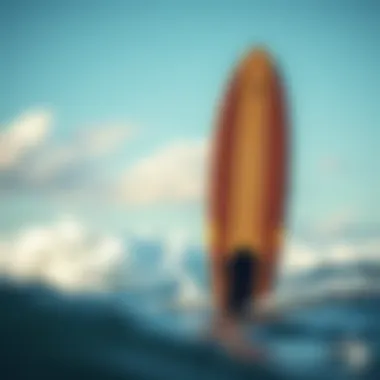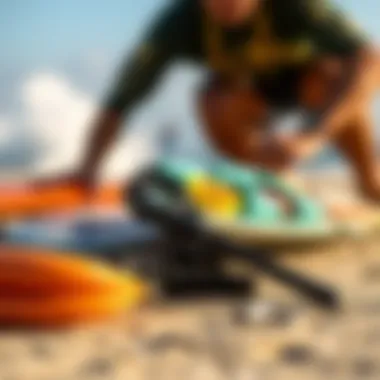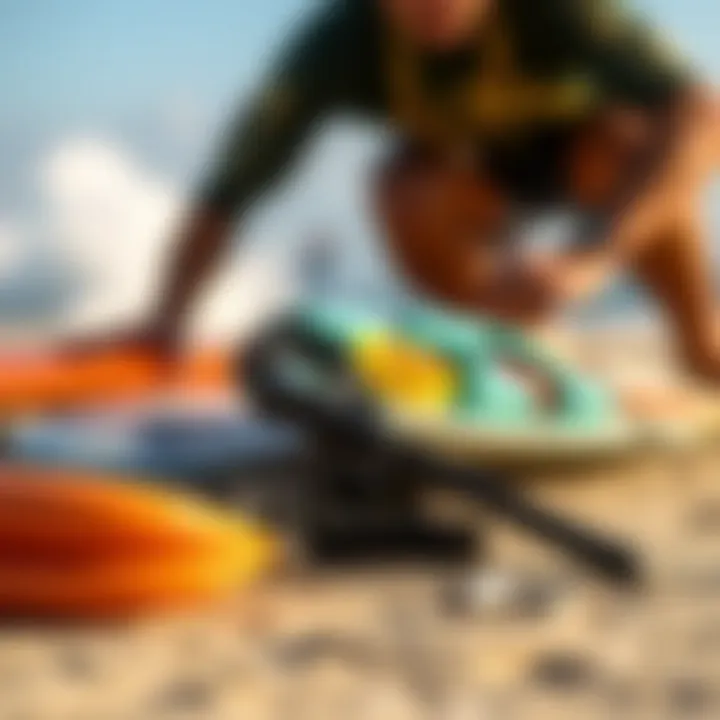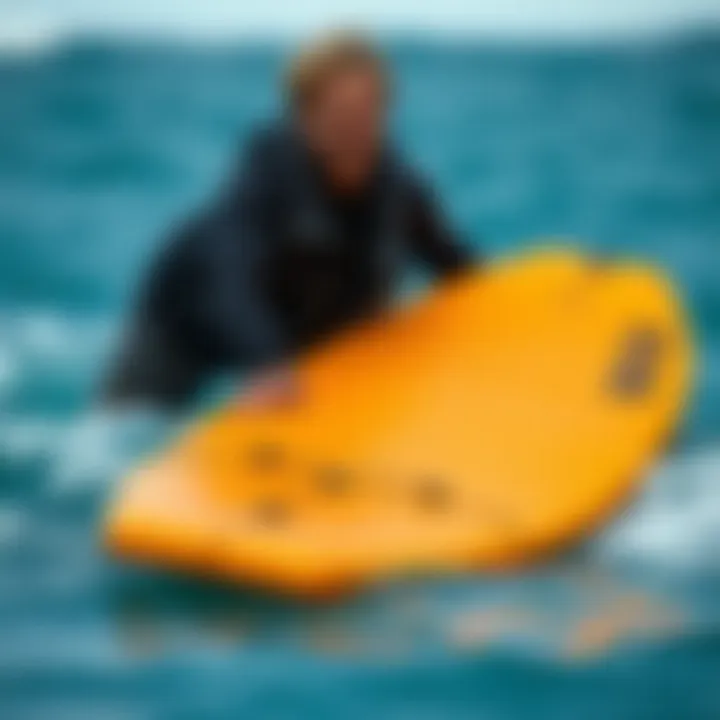Essential Wakesurf Practice Boards: A Complete Overview


Intro
Wakesurfing isn't just a thrilling sport; it’s a way of life for many who find joy gliding across the water's surface. To make the most of this dynamic activity, one needs to understand the importance of wakesurf practice boards. These boards bring the ocean's waves closer to home, allowing surfers to hone their skills in local lakes or rivers. This guide explores various aspects of wakesurf practice boards, why they matter, and how to effectively utilize them.
Why Wakesurf Boards Matter
Wakesurf boards are specifically designed to enable surfers to ride the wake generated by a boat without the use of a tow rope. This design encourages a more profound connection with the water, enhancing balance and control. Choosing the right board can mean the difference between struggling in the water and mastering those surf tricks.
In this article, we will outline:
- The intricate details of design and functionality in wakesurf boards.
- Types of boards available in the market and how they cater to different levels of surfers.
- Insightful advice on maintenance and safety considerations.
- Techniques to maximize your wakesurfing experience.
This comprehensive exploration will provide readers, especially surfers, instructors, and lifestyle bloggers, with the knowledge to choose wisely and practice effectively on their wakesurf boards.
Prolusion to Wakesurfing
Wakesurfing, a unique sport, bridges traditional surfing and wakeboarding, offering a way for enthusiasts to ride the wake of a boat without being directly pulled by a rope. This practice emphasizes skill, balance, and an understanding of water dynamics. Above all, it stands as a testament to innovation in water sports, and its rise in popularity cannot be overstated.
History of Wakesurfing
The roots of wakesurfing can be traced back to the mid-1990s, when passionate surfers sought a way to mimic ocean waves while on freshwater lakes. Early adopters of this trend would modify their boats to create a larger wake. They harnessed speed and momentum to surf effectively—similar to a dream, where the limitless ocean and a calm lake blended into one.
As the new millennium approached, wakesurf boards began to evolve alongside the sport. They transformed from rudimentary homemade versions into highly specialized boards designed for performance and comfort. Today, the modern wakesurf board, with its varying shapes and materials, reflects years of experimentation and improvement. Communities formed around this new sport, and competitions sprouted, further solidifying wakesurfing’s role in the broader surfing culture.
Wakesurfing vs. Traditional Surfing
Comparatively, wakesurfing and traditional surfing diverge significantly in technique and environment. In traditional surfing, practitioners paddle out into ocean swells, waiting for the perfect wave to catch. It's a dance with nature, requiring patience and timing, as the sea dictates the rhythm.
Conversely, wakesurfing revolves around a controlled environment. Riders rely on the boat’s wake, which can be shaped and adjusted. This gives surfers the unique ability to experiment with tricks and turns without the uncertainty of shifting tides. Therefore, it isn’t uncommon to see a wakesurfer tackling a maneuver with the same finesse as a surfer during a competitive heat, though the conditions and context may differ greatly.
Moreover, safety is inherently different between the two. While traditional surfers face the unpredictability of ocean currents and marine life, wakesurfers contend with proximity to the boat and potential equipment hazards. As such, understanding the nuances of both sports is vital for anyone eager to explore the world of wakesurfing.
"Wakesurfing represents the crossroads where innovation meets tradition, allowing surfers to ride on lakes while still capturing the essence of oceanic surfing."
Ultimately, the connection that wakesurfing fosters with water and community sets it apart, thus crafting a vibrant subculture that thrives on shared experiences and adrenaline.
Understanding Wakesurf Practice Boards
In the world of wakesurfing, practice boards are vital tools that enable riders to hone their skills and maximize their potential on the water. These boards differ significantly from typical wakesurf boards, as they are designed specifically for practice purposes, allowing surfers to refine their techniques without the added distractions of faster waves or unpredictable surf conditions. Understanding the nuances of these boards is essential for riders at all levels, from curious beginners to seasoned pros.
Definition and Purpose
Wakesurf practice boards are a unique subset of wakesurfing equipment crafted to enhance a rider's learning curve. They serve a distinct purpose, bridging the gap between capability and confidence. A practice board is generally lighter, more buoyant, and often comes with features that promote easier balance and maneuverability. Riders can use practice boards to develop muscle memory and improve their overall comfort on the water.
Key Features of Wakesurf Boards
Shape and Size
The shape and size of a wakesurf practice board play pivotal roles in its performance. Generally, larger boards provide more buoyancy and stability, which is an ideal feature for those still working on their balance. Conversely, smaller boards may allow for faster turns and tricks but can be more challenging to control.
The key characteristic of these boards is their outline. A wider nose can increase stability, while a tapered tail offers the rider improved maneuverability. For beginners, boards that are around 5-6 feet in length can be quite beneficial. This size provides both support and flexibility, catering to various skill levels while encouraging continued practice.
- Advantages: Easy to balance for learners
- Disadvantages: Might restrict advanced tricks due to size
Material Composition
Understanding the material composition of wakesurf practice boards is crucial. Boards are commonly made from foam, fiberglass, or epoxy. Foam boards are notably lightweight and buoyant, making them a popular choice for novices. Their soft surfaces are forgiving, reducing the risk of injuries during falls. However, they may lack the durability of firmer options.
An important point about fiberglass boards is that they are generally more rigid, providing better control at higher speeds but requiring a bit more experience to handle effectively. While epoxy boards combine the advantages of both, they can be pricier but often justify the cost through their enhanced performance and longevity.
- Key Trait: Lightweight yet robust options can exist in the market
- Consideration: Need for a balance between durability and ease of use
Fin Configuration
The fin setup on a wakesurf board can drastically change the boarding experience. Boards with multiple fins often offer greater stability and control, which is favorable for practice. In contrast, a single fin setup might appeal to riders focusing on more advanced maneuvers, as it allows for looser turns.
Choosing the right fin configuration can depend largely on the rider's needs—beginners may benefit from a board equipped with twin fins for extra stability, while those aiming to perform tricks may prefer a thruster setup that offers responsiveness and the ability to carve sharper angles in their turns.
- Benefit: Greater control and stability leads to improved confidence in riders
- Caveat: Advanced setups may feel restrictive during learning phases


"Understanding board specifics can be the difference between struggling and thriving in your wakesurfing journey."
Ending
In essence, knowing how to select and make use of wakesurf practice boards amplifies a rider's ability to learn and adapt on the water. Each characteristic—from shape and material to fin setup—plays into the overall experience and fostering skill acquisition. Focusing on these elements when choosing one’s practice board can set the stage for success, whether the goal is to catch waves effortlessly or to nail that next big trick.
Types of Wakesurf Practice Boards
Wakesurf practice boards are not just tools for fun; they represent a spectrum of designs tailored to various riding styles, preferences, and skill levels. Understanding the different types of wakesurf boards is essential for any aspiring surfer who wants to maximize their experience on the water. Each board type brings unique benefits and challenges, making it crucial to select one that suits individual needs.
Surf Style Boards
Surf style boards are designed with the traditional surfer in mind, offering a broader, more stable platform that replicates the feel of ocean surfing. They often feature a pointed nose and a wider tail, which allows for better maneuverability and responsiveness when carving through the wake.
Benefits of Surf Style Boards:
- Stability: The width gives beginners confidence as they learn how to balance.
- Maneuverability: Ideal for making sharp turns and tricks, enhancing the surfing experience.
- Performance in Various Conditions: They excel in varied wake sizes and shapes, making them versatile.
Consider these boards if you aim to execute high-quality turns and tricks while practicing your balance. They often come with three-fin setups that enhance stability and control, especially useful for novice surfers aiming to build their skills.
Skim Style Boards
Unlike their surf-style counterparts, skim style boards are shorter and lighter, designed primarily for those who intend to perform tricks and spins. These boards more resemble skateboards than traditional surfboards.
Advantages of Skim Style Boards:
- Lightweight: Easy to maneuver, allowing for a quick learning curve on spins and tricks.
- Surface Tricks: Designed for riders who want to focus on tricks rather than just cutting through the wake.
- Quick Response: The smaller size allows for rapid reactions, making it easier to adjust to changing conditions.
If you're looking to take your skills to the next level and perhaps showcase some impressive tricks on the water, skim boards are a solid choice. With a flatter rocker profile, they excel in performing spins like 360s and even shuv-its, making them a favorite among advanced riders.
Hybrid Boards
For those who want the best of both worlds, hybrid boards offer a middle ground between surf style and skim style boards. These versatile boards are shaped to perform well in a range of situations and are ideal for surfers who want the ability to switch it up.
Key Features of Hybrid Boards:
- Dual Performance: Combines features from both styles, allowing for surf-style cutbacks and skim-style tricks.
- Versatility: Suitable for different wakes and riding styles, great for groups with varying skill levels.
- Adjustable Fin Configurations: Often come with interchangeable fin setups that adjust according to the rider's preference.
These boards are perfect for those who may not want to be pigeonholed into a single riding style. Hybrid boards adapt to their rider, whether hitting the wake for a traditional ride or practicing spins.
“Choosing the right wakesurf board is like picking the right pair of shoes; it can change your whole experience on the water.”
Understanding these specific types of wakesurf practice boards will aid in refining your skills and enhancing your overall riding experience. Whether you're a beginner still trying to find your footing or an experienced skater looking to refine your tricks, there's a board tailored for you.
Selecting the Right Wakesurf Practice Board
Choosing the right wakesurf practice board is not just a matter of preference; it’s akin to finding the right tool for a job. Each board has its unique design features catering to different skill levels, riding styles, and budgetary constraints. The right board can greatly enhance your surfing experience, fostering confidence, agility, and skills on the water.
Selecting the perfect wakesurf board involves a careful evaluation of your own experience and preferences, as well as a solid understanding of the characteristics of the boards available.
Skill Level Considerations
When it comes to wakesurfing, a beginner's approach drastically differs from that of an advanced rider. If you're new to the sport, you might gravitate toward wider boards with a more stable base. These help maintain your balance as you get comfortable on the water. Beginners often benefit from longer boards that offer a larger surface area, preventing a quick wipeout during early attempts.
On the flip side, seasoned surfers often look for more maneuverable boards. For instance, a shorter board can provide more dynamic movement, allowing for tricks and sharp turns. Knowing whether you are still finding your feet or perfecting aerial spins is crucial when making your decision.
Riding Style Preferences
Your riding style significantly impacts your board selection. Not all wakesurfing is done the same way; some enthusiasts prefer chill, long rides that require a board that maintains straight lines, while others prefer a more aggressive approach with sharp turns and technical tricks.
- Surf Style Boards: Ideal for those who ride in a more fluid fashion, mimicking traditional surfing. These boards generally have a rounded nose and are designed for carving.
- Skim Style Boards: Suited for riders who want to perform spins and tricks. They are typically shorter and designed for easy maneuvering.
- Hybrid Boards: A mix of both styles, offering a balance between stability and agility.
Tailoring your choice to how you want to ride is essential; this will shape your experience and level of enjoyment.
Budget Factors
Let’s not beat around the bush—money plays a role in any purchase, especially when it comes to wakesurf practice boards. You’ll find boards that vary widely in price, so understanding your financial boundaries can streamline the selection process.
While it's tempting to pick the cheapest option available, be cautious. A well-constructed board built with quality materials can significantly enhance your performance and durability. Rather than buying impulsively, think about:
- Long-Term Investment: Sometimes spending a bit more upfront saves money in the long run as the board won't need replacing soon.
- Resale Value: Certain brands hold their value better. You might find that a previously purchased board can fetch a fair price down the line.
- Sales and Discounts: Keep an eye out for local retailers or online stores that might offer mid-season sales, allowing you to snag a quality board without breaking the bank.


Excelling in wakesurfing requires the right equipment. Putting thought into your board selection can lead to countless enjoyable days on the water, sharpening your skills and making the most of this exhilarating sport.
"The best surfer out there is the one having the most fun."
— Duke Kahanamoku
For further reading on surfboard design and types, you may explore resources such as Wikipedia or engage in discussions on platforms like Reddit.
Choosing the right wakesurf practice board means understanding your skills and preferences. Take your time, research your options, and invest in a board that feels right for you.
Maintaining Your Wakesurf Practice Board
Keeping your wakesurf board in top shape is essential for both performance and longevity. Much like any other sports equipment, a little TLC goes a long way in preserving the integrity of your board and ensuring safety while riding. Over time, water, sun exposure, and general wear and tear can impact the performance. By taking the time to regularly maintain your board, you not only enhance your wakesurfing experience but also save money in the long run by avoiding the need for frequent replacements.
Cleaning and Care
Cleaning your wakesurf board is not just a matter of aesthetics; it's about ensuring the board remains functional and safe. After a day out on the water, it's advisable to rinse your board with fresh water. This helps to wash away salt or chlorine, which can erode the board’s materials over time.
- Quick Steps for Cleaning:
- Rinse Off: After each use, rinse your board thoroughly with fresh water to remove any debris or chemicals.
- Gentle Soap: Use a soft sponge and mild soap to scrub off any stubborn spots. Avoid harsh chemicals that can damage the board's surface.
- Dry Thoroughly: Be sure to dry it completely before storing to prevent mold or mildew growth.
If you notice scratches or dings, these can often be repaired with a simple epoxy kit. It’s best to address these issues sooner rather than later, as failing to do so can lead to bigger problems down the road.
"A well-maintained board is like a well-tuned engine; it performs better and lasts longer."
Storage Solutions
Where and how you store your wakesurf board can greatly influence its lifespan. Keeping it in optimal conditions is key. Direct sunlight, extreme heat, or cold can warp the material, leading to performance issues.
- Storage Tips:
- Cool and Dry Place: Store your board in a cool, dry location to avoid warping and moisture damage.
- Board Bag: Invest in a good board bag that not only offers protection from physical damage but also UV protection against sunlight.
- Vertical Position: If possible, store your board vertically. This prevents pressure points that can create permanent bends in the board.
By adhering to these cleaning and storage practices, you’ll ensure that your wakesurf board remains a reliable companion on the water for many seasons to come.
Safety Considerations in Wakesurfing
In wakesurfing, safety should always take precedence, no matter how experienced one might be. This sport, while thrilling, has its fair share of risks. The right precautions not only protect individual surfers but also ensure that everyone on the boat and around the water stays safe. The significance of safety in wakesurfing stretches beyond just precautionary measures; it encompasses understanding the environment, the equipment one uses, and the necessary personal gear.
Equipment Safety Standards
One key aspect to consider is the equipment safety standards. All wakesurf boards aren't just built for performance; they must also meet certain safety regulations. This includes the materials used, the construction methods, and the design itself. For example, boards made of durable composites will generally withstand impacts better than weaker materials.
Beyond boards, it's essential to ensure that any boat used for wakesurfing is properly equipped and maintained.
- Make sure the boat meets local and state regulations concerning speed, noise, and safety features.
- Ensure that the boat’s ballast system is in proper working order, as this affects the surf wave's size and consistency.
Because manufacturers often have to comply with standard certifications, such as the American Boat and Yacht Council (ABYC) standards, keeping one's eyes peeled for such seals can guide consumers in making safer choices.
Personal Safety Gear
Life Jackets
Life jackets are indisputable when it comes to personal safety gear in wakesurfing. These jackets are designed to provide buoyancy and keep a person afloat in the water. Every wakesurfer, irrespective of skill level, should wear one while out on the water.
- A well-fitted life jacket is, undoubtedly, a beneficial choice. It allows mobility and won’t hinder movements—a critical factor when trying new tricks in the waves.
- Look for jackets with features like adjustable straps and lightweight designs to enhance the experience.
- Be aware, however, that some life jackets might restrict arm movements; it's crucial to find a balance between safety and performance.
Footwear
When it comes to footwear, the choice can significantly influence a wakesurfer’s experience. Specialized wakesurf shoes provide not only grip but also protect against sharp objects and the heat of the sun. The right type of footwear can enhance one’s control on the board.
- A key characteristic of these shoes is the non-slip sole, which maximizes grip on the board, especially during tricky maneuvers.
- Many beginners find that good footwear instills more confidence, enabling them to focus on learning rather than worrying about falling.
- On the downside, some might argue that shoes can add extra weight and stiffness. Nonetheless, the trade-off often favors safety and support, particularly for novice surfers.
As is clear, taking safety into account is essential not only for personal protection but also for fostering a responsible wakesurfing culture. Ensuring equipment meets safety standards, wearing the proper gear, and adopting a cautious attitude can make all the difference between a day of exhilarating fun and a potential mishap in the water.
"Safety isn't just a priority; it's a prerequisite in enjoying the thrill of wakesurfing."
By investing in safety and being aware of the standards and equipment, surfers can enjoy the sport to its fullest while minimizing risks.
Training Techniques for Wakesurfing
Wakesurfing is not just about catching a wave. It's a blend of skill, balance, and technique. Proper training techniques are vital in helping surfers develop these skills and advance their overall performance on the water. This section will explore the key elements of effective training, highlighting both the benefits and considerations needed for anyone looking to improve or get started in wakesurfing.


The right techniques can set you apart, allowing for enhanced balance, precision, and a smooth ride. Learning how to master the basics while also diving into more complex movements can transform your wakesurfing experience and elevate your skills. Having a good grasp of various training techniques often results in more enjoyable and safer experiences on the water.
Basic Balancing Skills
Finding your equilibrium is the first step towards mastering wakesurfing. Basic balancing skills are fundamental, as they form the backbone of everything else. To get started:
- Stance: Stand shoulder-width apart with your weight equally distributed. Flex your knees slightly. This position provides a stable foundation for dynamic movements.
- Core Engagement: Your core muscles are essential in maintaining stability. Engaging them helps you stay upright and correct your posture when necessary. Planks and simple stretches on land can significantly help in strengthening your core.
- Foot Placement: Experiment with foot placement. Usually, front foot positioned near the center gives you better control, while shifts may be necessary depending on the wave conditions.
- Weight Distribution: Learn to shift your weight from one foot to the other. This skill is crucial when navigating through waves and performing tricks.
"Balancing on the board feels like walking a tightrope. Once you get it down, the tricks flow like water!"
Regular practice of these balancing exercises can lead to improved confidence and performance on your wakesurf board. Small drills such as riding behind the boat without the rope can build balance under real conditions.
Advanced Maneuvers
Once you've nailed the basics, the next step might feel like stepping into a whole new world of possibility. Advanced maneuvers in wakesurfing allow riders to express creativity, showcasing skills developed through dedicated practice.
- 180 Spins: This move involves a quick turn while in motion. Start by carving left or right and swiftly shifting your body weight. It’s tricky but worth the effort.
- Air Tricks: Get that board off the wave! Find ways to pop into the air by using the wave's lip. Start with small hops before moving on to bigger airs like 360s or jumps.
- Grabs: This trick involves reaching down and grabbing your board while in the air. It adds flair to your jumps and can be practiced both on flat water and while surfing.
- Switch Riding: Riding with your opposite foot forward can open up a different perspective and is crucial for versatility in your riding style.
- Practice Variety: Mixing up your maneuvers helps build muscle memory and confidence. Regularly incorporate new tricks in your practice sessions to challenge yourself and keep the experience fresh.
- Observation: Watch videos or join local wakesurf clubs to observe others. Studying advanced riders can provide you with new ideas and techniques.
With consistent practice and the right guidance, these advanced maneuvers can greatly increase your skill level and enjoyment of the sport. Stay patient, as improvement may take time, but the reward is a thrilling wakesurfing experience.
For more insights, check out Wikipedia on Wakesurfing or join discussions on Reddit's Wakesurf Community.
Training techniques in wakesurfing not only improve performance but also contribute to a satisfying engagement with a sport that constantly evolves. Embrace the process, and your skills will flourish.
Wakesurfing Communities and Learning Resources
Engaging in wakesurfing is not solely about hitting the water; it’s also about being part of a community. Wakesurfing communities offer essential resources, knowledge exchange, and opportunities for growth. The support and camaraderie fostered in these groups can make a huge difference in a surfer's development, helping them push their limits and expand their skills.
Local Wakesurf Clubs
Local wakesurf clubs play a pivotal role in the sport. Joining a club allows surfers to connect with like-minded individuals who share their passion for wakesurfing. These groups often organize regular meets, events, and outings that provide valuable hands-on experience.
Participating in club activities can help newcomers learn the ropes with skilled instructors and seasoned surfers guiding them along the way. Also, being part of a local club creates lasting friendships. Clubs often foster a supportive environment where novices are encouraged and experienced members share techniques.
- Networking Opportunities: Members have access to various contacts, from competitors to enthusiasts.
- Skill Development: Clubs offer workshops that cover a wide range of techniques, from basic to advanced maneuvers.
- Events and Competitions: Local competitions can help surfers gain experience in a less pressured setting while also providing a sense of accomplishment.
A quick search on platforms like Facebook or Reddit can help you find clubs nearby that suit your needs and interests. Partnering with clubs can really boost not only the experience but the collective know-how of its members.
Online Forums and Tutorials
The digital age has transformed how we learn and connect. Online forums and tutorials have emerged as valuable assets for wakesurfing enthusiasts. These platforms allow users to gather information, share experiences, and get advice—essentially creating a virtual clubhouse for surfers around the world.
Engaging in online communities provides access to a wealth of knowledge. Members can post questions, share their rides, or even document their progress, receiving feedback from experienced surfers. Additionally, many forums compile extensive resources, such as tips for gear maintenance or training exercises.
- Instructional Videos: YouTube channels specializing in wakesurfing can provide visual guidance for various skills and techniques.
- Accessible Tutorials: Websites often offer free resources, breaking down complex maneuvers into digestible steps.
- Connect with Experts: Some forums have professionals who contribute insights, adding depth to discussions.
To get started, check out www.wakesurfing.com or www.reddit.com/r/wakesurfing for engaging conversations and a wealth of information. In this environment, both novice and veteran surfers can continue to cultivate their love for wakesurfing.
“Learning from experienced surfers in community settings can be one of the fastest ways to improve your skills.”
The Future of Wakesurf Practice Boards
The landscape of wakesurfing is continuously shifting, reflecting advancements not only in technology but also in the culture that surrounds this exhilarating sport. As we delve into the future of wakesurf practice boards, we uncover both the exciting innovations on the horizon and the pivotal shift towards more sustainable practices. These elements are crucial as they not only improve performance but also ensure that the sport remains accessible and environmentally friendly for generations to come.
Innovations in Board Design
The wakesurf boards of tomorrow are set to be a marvel of engineering and design. Innovations in materials, shapes, and technology are paving the way for boards that are lighter, faster, and more responsive. For instance, the use of advanced composite materials, such as carbon fiber and new foam technologies, is revolutionizing board construction. These materials can drastically reduce weight while enhancing buoyancy and durability.
Moreover, the shape of the board itself is undergoing significant changes. Manufacturers are experimenting with various rocker profiles and tail shapes to enhance maneuverability and provide better performance for all skill levels. It's getting common to see boards equipped with adjustable fins, allowing surfers to customize their ride according to their preferences and conditions on the water.
"The continuous evolution in wakesurf board design showcases how blending technology with craftsmanship can lead to superior performance."
Another exciting trend is the incorporation of smart technology in wakesurf boards. Imagine a board that can track your performance metrics like speed, balance, and even wave height. Such features not only provide immediate feedback to surfers but can also contribute to a more targeted training regimen. This convergence of surfing with technology is thrilling and indicates a bright future for those passionate about the sport.
Sustainability Practices
As the wakesurfing community grows, so does the responsibility to protect our water resources and the environments they thrive in. Sustainability practices are becoming central to the future of wakesurf practice boards. Many manufacturers are shifting their production processes toward more eco-friendly materials. For example, boards made from recycled materials or sustainable resources are now entering the market, allowing surfers to ride with a clear conscience.
Additionally, the average surfer is becoming increasingly aware of their environmental footprint. This shift is driving demand for products that are sustainably made and promote ocean conservation. Brands that focus on minimizing waste during their manufacturing process and those that actively participate in environmental initiatives are gaining popularity.
Here’s how surfers and manufacturers alike can embrace sustainability:
- Use eco-friendly materials: Boards crafted from renewable or recycled materials are available and on the rise.
- Support brands with green initiatives: Choose to buy from companies that donate a portion of their profits to ocean conservation.
- Reduce waste: Practices such as repairing damaged boards rather than discarding them contribute significantly to sustainability.
With these transformations in design and a focus on sustainability, wakesurfing is poised not just to endure but to thrive.







